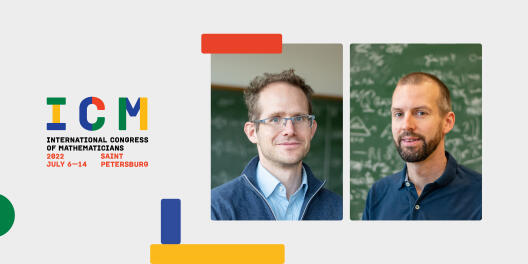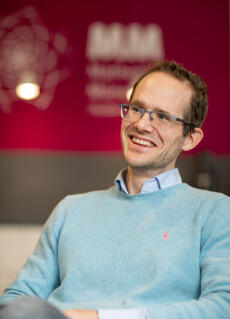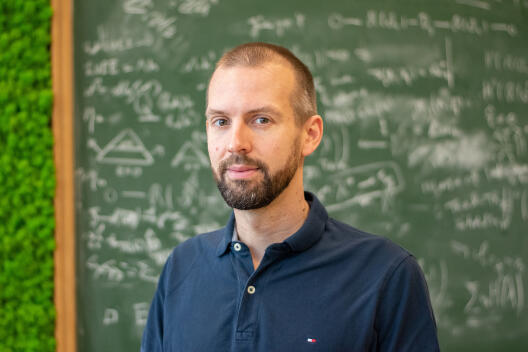Two researchers from Mathematics Münster at ICM 2022

++ Update 26 Feb. 2022: The Executive Committee of the International Mathematical Union (IMU) has decided that the ICM 2022 will take place as a fully virtual event, hosted outside Russia. From the IMU statement: "We strongly condemn the actions by Russia. Our deepest sympathy goes to our Ukrainian colleagues and the Ukrainian people. Given this situation, it is impossible for the IMU to host the ICM and the GA as traditional in-person events in Russia." read full IMU statement ++
Prof Gustav Holzegel and Prof Thomas Nikolaus, both members of the Cluster of Excellence Mathematics Münster, have been invited to talk about their research at the International Congress of Mathematicians (ICM) being held in St Petersburg in July. The ICM takes place every four years and is the oldest, largest and – scientifically speaking – most important event in the field of mathematics.
Gustav Holzegel will be a "special invited speaker" and, together with Prof Peter Hintz (ETH Zurich), present an overview of recent progress made on the General Theory of Relativity. Both mathematicians will be presenting their talks in three sections: geometry, partial differential equations and mathematical physics. This structure reflects both the relevance of the work for the different fields of mathematics and, very appropriately, the Cluster’s aim to "bridge the gaps" between the various branches of mathematics.
Thomas Nikolaus will be giving a talk in the topology section. His main research focuses are homotopy theory and algebraic topology, but his work also relates to arithmetic and mathematical physics. More specifically, he works on (algebraic) K-theory, topological cyclic homology and various related areas. He pioneered the use of higher categorical methods to approach and solve various problems in the field. His earlier work also concerns differential cohomology theories, operads, topological field theories and mathematical physics.
In the interviews below (click to unfold), the two scientists provide insights into their research areas and their expectations for the conference in St. Petersburg.

Gustav Holzegel© Uni MS/Peter Leßmann Interview with Gustav Holzegel
What does the invitation to the ICM mean to you?
The invitation is a great honour, of course, and I see it as recognition for my work.What is so special about the "special sectional lectures" at which you will be speaking?
These were introduced a few years ago with the aim of presenting certain fields of mathematics that maybe don’t fit exactly into any one of the sections, but extend into several. The General Theory of Relativity is closely allied to partial differential equations, geometry, mathematical physics and analysis, and is therefore well suited to such a format.You will be giving presentations together with Peter Hintz. Will you be talking about joint findings, or will you be discussing different aspects?
We’ll be discussing different aspects of the same field of research. Peter and I are working on similar problems, sometimes using quite different methods. The idea of the talk is also to identify connecting elements and to look at the field of the General Theory of Relativity from many different mathematical angles.Which aspects of the ICM are you looking forward to as a speaker? And which as a participant?
It’s great to have such a large audience! What I’m also looking forward to is preparing the talk with Peter, having discussions with a lot of colleagues face-to-face and listening to interesting talks on a wide variety of fields. And I’ve never been to St. Petersburg before. After the long Corona period, a trip like this is exciting from a non-mathematical point of view as well!Could you tell us something about your field of research?
Albert Einstein's General Theory of Relativity revolutionised our understanding of the universe. The mathematical form of his theory of gravity is provided by the so-called Einstein field equations, a complicated system of ten non-linear, coupled, partial differential equations at the interface between geometry and analysis. Among other things, these equations are the foundation of modern cosmology, they allow for the description of gravitational waves and predict the existence of black holes.The study of black holes is a field of research that had its heyday in theoretical physics in the 1960s and 1970s and is associated with names such as Hawking and Penrose. Through mathematical progress in the field of partial differential equations, many open problems from this period have become mathematically accessible in the last 20 years.
The question of the dynamic stability of black holes is one example. The aim is to prove that the Einstein equations evolve small perturbations of the geometry of black holes into geometrically similar solutions. Some time ago, my collaborators and I succeeded in proving this behaviour for the simplest class of solutions describing black holes. The proof combines insights from the former "heyday" in physics with modern mathematical methods for the analysis of geometric non-linear differential equations.
What questions are you working on at the moment and why are they interesting or important?
In general, I’m trying to understand the non-linear Einstein field equations in various dynamic contexts – for example, the dynamics of black holes or asymptotically anti-de Sitter spacetimes. This leads to questions about how linear and non-linear hyperbolic equations behave in spacetimes with black holes. This is of interest from a mathematical point of view because geometrical methods have to be developed in the theory of non-linear partial differential equations in order to control the dynamics by means of estimates.For some years now, the measurement of gravitational waves has provided us with an experimental opportunity to draw conclusions about black holes in the universe from the wave signals measured. This means that we can learn both experimentally and theoretically about the dynamic processes in our universe and re-examine the validity and limits of mathematical models.
What are the most recent results of your research?
After a long time and working together with Mihalis Dafermos, Igor Rodnianski and Martin Taylor, I completed a proof for the stability of the Schwarzschild solution in April. The methods developed in this process can also be applied to other dynamic problems. That’s what we’re currently working on.
Thomas Nikolaus© MM/vl Interview with Thomas Nikolaus
What does the invitation to the ICM mean to you?
I was very happy when I got the invitation, particularly as the invitation is not only an honour and appreciation for my own work, but also for my field of research, which is a relatively young area.Can you give us a quick general overview of your field of research?
My research is located in the area sometimes called "higher algebra" or "higher categorical algebra". This area lies at the intersection of two classical mathematical fields: algebra and topology.In algebra, we study algebraic objects of different kinds such as polynomial equations or rings. Rings are sets within which one can calculate similar to the integers. This means that one can add and multiply elements.
Topology is about the properties of geometric objects, e.g. surfaces in ambient space, which are invariant under continuous deformations. That means one is allowed to arbitrarily deform, squeeze and bend surfaces, but one cannot tear them apart. From this point of view, a coffee cup with a handle is equivalent to a donut.
In my area of research, these two aspects are combined. We study objects which possess a topological structure, i.e. can be deformed, but whose points can, at the same time, also be added and multiplied. The subtlety is that the usual arithmetic rules themselves are deformed. For example, a + b is generally not equal to b + a but only equivalent in a weaker sense. These objects are called ring spectra and play an important role in different applications and questions in topology and algebra.
Ring spectra are very complicated, which is why they have only been effectively studied since the systematic development of higher category theory around the late 2000s. This breakthrough made it possible to generalize classical algebraic methods from rings to ring spectra. But the vision of using ring spectra to approach geometric questions is much older and dates back, at least, to the 1970s. It was pioneered by the mathematician Friedhelm Waldhausen who also coined the provocative term "brave new algebra" for this area.
What is the topic of your talk at the ICM?
Specifically, I will talk about a generalization of the Frobenius-Homomorphism to "higher algebra", i.e. for ring spectra, and explain some applications. The existence of the classical Frobenius homomorphism is a central aspect of the modern theory of rings.Therefore, it is very important to define and study a similar homomorphism for ring spectra. In my talk, which is based on several articles written in the last few years, I will discuss how to construct a generalized Frobenius homomorphism for ring spectra and relate this to several current research directions and questions, e.g. computations in algebraic K-theory.
Which questions are you currently working on and what are your latest results?
In addition to some K-theory computations, I am currently trying to prove a certain generalization of the Segal conjecture. If this conjecture turns out to be true then it should lead to several striking applications in homotopy theory, e.g. classification of topological spaces by means of stable coalgebras.Another long-term project that I have been working on for a while now (with various coauthors) is the computation of the stable cohomology of certain arithmetic groups such as the orthogonal and symplectic groups over the integers Z. For many years we have been developing methods to reduce these computations to much more accessible computations in K-theory.
Using this body of work, we are now able to describe these stable cohomology groups completely, at least at regular primes.
What are you especially looking forward to at the ICM as a speaker and as a participant?
I am looking forward to seeing the whole mathematical community united in one place. Usually, the conferences we attend are focused on one narrow aspect of mathematical research. Therefore, the ICM is something very special with all the disciplines represented. I am also very excited to see many new results and directions presented there.
Links:
International Congress of Mathematicians (ICM) 2022 - Special Sectional Lectures
International Congress of Mathematicians (ICM) 2022 - Section Topology

